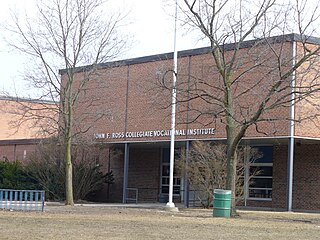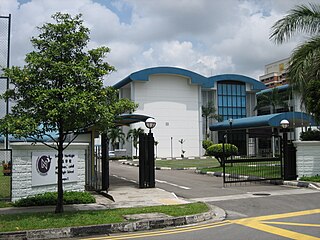
Vocational education is education that prepares people for a skilled craft as an artisan, trade as a tradesperson, or work as a technician. Vocational education can also be seen as that type of education given to an individual to prepare that individual to be gainfully employed or self employed with requisite skill. Vocational education is known by a variety of names, depending on the country concerned, including career and technical education, or acronyms such as TVET and TAFE.
Hellyer College is a government comprehensive senior secondary school located in Burnie in north-western Tasmania, Australia. Established in 1976, the college caters for approximately 630 students in Years 11 and 12 and is administered by the Tasmanian Department of Education. Hellyer College is situated on the same campus as the TAFE Tasmania and 250 metres (820 ft) from the Cradle Coast campus of the University of Tasmania, on Mooreville Road.
The education system in Tasmania comprises the education of children from their early years, through kindergarten, primary and high school, and tertiary education in universities and vocational education and training organisations. The system is delivered by the government-run K-12 schooling system, and numerous independent schools and colleges, most of which are controlled or sponsored by religious organisations. Public education in Tasmania is managed primarily by the Tasmanian Department of Education. The Department is responsible for all aspects of education in Tasmania including schooling, adult education, the State Library and TasTAFE, a vocational tertiary institution with many campuses around the state.

Hobart College is a government comprehensive senior secondary school located in Mount Nelson, a suburb of Hobart, Tasmania, Australia. Established in 1913 as Hobart High School, it was later renamed as Hobart Matriculation College in 1965, and subsequently renamed as Hobart College. The college caters for approximately 1,000 students in Years 11 and 12 and is administered by the Tasmanian Department of Education.

Guilford Young College is a Roman Catholic senior secondary college, with campuses located in the Hobart suburbs of Glenorchy and Hobart City in Tasmania, Australia. The College provides education to students in Year 11 and Year 12, offering more than 100 Tasmanian Certificate of Education (TCE), pre-tertiary and Vocational Education and Training (VET) courses. The college is named in honour of Sir Guilford Young who served as the eighth Archbishop of Hobart from 1955 to 1988.

Elizabeth College is a government comprehensive senior secondary school located in Hobart, Tasmania, Australia. Established in 1911 as the Elizabeth Street School and known as Elizabeth College since 1985, the college caters for approximately 1,000 students in Years 11 and 12 and is administered by the Tasmanian Department of Education.
The Western Australian Certificate of Education (WACE) is the credential awarded to students who have completed senior secondary education in the state of Western Australia. It is the Western Australian graduation certificate of the Australian Senior Secondary Certificate of Education. Students are required to meet various breadth and depth requirements, achievement standards and literacy and numeracy standards across their final years of schooling. As of the 2020 WACE, there are 106 courses available for students to study. Many WACE students are awarded an Australian Tertiary Admission Rank (ATAR), summarising their results across all areas of study into one ranking for the purposes of university admission. Students may choose from ATAR courses, which count directly towards their ATAR, Vocational Education and Training courses, which are more practical courses and can lead to further vocational opportunities, and, from 2021, General courses, which provide pathways to university, employment, or further vocational education and training. From 2010, the WACE replaced the Tertiary Entrance Exam (TEE), as the standard academic examination for school leavers in Western Australia.

Salesian College Celbridge is a secondary school catering for male students aged 12–19 around the County Kildare village of Celbridge in Ireland.

Newstead College is a government comprehensive senior secondary school located in Newstead, a suburb of Launceston, Tasmania, Australia. Established in 1997, the college caters for approximately 500 students in Years 11 and 12. The college is administered by the Tasmanian Department of Education.
Huonville High School is a government co-educational comprehensive secondary school located in Huonville, a town to the south of Hobart, Tasmania, Australia. Established in 1940, the school caters for approximately 400 students from Years 7 to 12. The Tasmanian Department of Education administers the school.

The Tasmanian Certificate of Education (TCE) is the main credential awarded to secondary school students who successfully complete senior high school level studies in Tasmania, Australia. It was introduced in 1992 to replace Tasmania's old "High School Certificate", and partially restructured for 2007.

NorthLight School is a school located along Towner Road, in Kallang, Singapore. It was established by the Ministry of Education (MOE) for students with difficulties handling the mainstream curriculum in the country. The school started its operations formally in January 2007 to assist students at risk of dropping out of school. Admission to the school is based on at least two failed attempts at the Primary School Leaving Examinations (PSLE). The school also accepts those who have yet to complete secondary education.
Reece High School is a government co-educational comprehensive secondary school located in Devonport, Tasmania, Australia. Established in the 1950s, the school caters for approximately 450 students from Years 7 to 12 and is administered by the Tasmanian Department of Education.

Education in Western Australia consists of public and private schools in the state of Western Australia, including public and private universities and TAFE colleges. Public school education is supervised by the Department of Education, which forms part of the Government of Western Australia. The School Curriculum and Standards Authority is an independent statutory authority responsible for developing a curriculum and associated standards in all schools, and for ensuring standards of student achievement, and for the assessment and certification according to those standards.

Launceston College is a government comprehensive senior secondary school located in Launceston, Tasmania, Australia. Established in 1913 as the Launceston State High School and subsequently known as Launceston College, the college caters for approximately 1,200 students in Years 11 and 12, and an optional Year 13. The college is administered by the Tasmanian Department for Education, Children and Young People.
Tasmania Tomorrow is a Tasmanian-government initiative which aims to improve the post-secondary education experience of Tasmanians. The initiative commenced 1 January 2009, and includes restructuring Senior Secondary Colleges and TAFE Tasmania. It was anticipated that the restructuring would be complete by the start of the 2011 school year.

Keysborough Secondary College is an Australian dual campus government coeducational school for students from years 7-12, with campuses located in Springvale South, Victoria and Keysborough, Victoria. The four participating schools were officially merged into Keysborough Secondary College on 6 October 2008. The merger is valued at $43 million.

The Australian Tertiary Admission Rank (ATAR) for all domestic students, or the ATAR-based Combined Rank (CR) for all International Baccalaureate (IB) students, are the primary criteria for determining the Selection Rank (SR) for admission into undergraduate courses in Australian public universities. Domestic Students are students who are Australian or New Zealand citizens, or Australian permanent residents, or the holder of long-term refugee visa. ATAR & CR are not applicable for international students as they must apply directly to each university separately and their SR is calculated by the university. The ATAR is calculated by each state or territory's own state-level Tertiary Admission Center (TAC) for all domestic students studying within their geographical limits. Interstate Domestic Students must apply to the TAC of their respective state. The Selection Rank is calculated by each University separately based on the ATAR or CR as well as additional points for each university's unique criteria such as a student's educational disadvantage or subject performance. ATAR is not a mark, but rather a percentile ranking between 0.00 and 99.95 which shows the student’s relative position compared to all other students in the range of 16 to 20 years old who would have completed their respective year 12 exams in that state in a year.
Esperance Senior High School is a comprehensive public high day and boarding school, located in Esperance, a regional centre 780 kilometres (485 mi) southeast of Perth, Western Australia.
Murrumba State Secondary College is an independent coeducational public secondary school based in Murrumba Downs in the local government area of the City of Moreton Bay, north of the Brisbane metropolitan area in Queensland, Australia. The school initially opened in 2012 as the first secondary school in Queensland to incorporate Year 7 as part of the Flying Start initiative.














